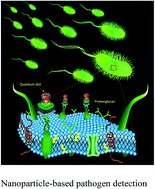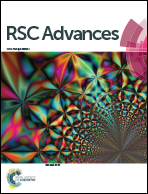Fluorescence detection of the pathogenic bacteria Vibrio harveyi in solution and animal cells using semiconductor quantum dots
Abstract
Validation of microbial infection pathways in eukaryotic cells is challenging in the control of various infectious diseases. Semiconductor nanocrystals, also called quantum dots (QD), due to their exceptional brightness and photostability can be exploited in the long term monitoring of pathogens in host cells. However, the limited information about interactions of QDs and their bioconjugates with microorganisms confines the microbiological applications of QDs. Here we investigate the binding and toxicity of CdSe/ZnS QDs to the free-swimming marine pathogenic bacteria Vibrio harveyi using fluorescence microscopy, elastase assay, polyacrylamide gel electrophoresis (PAGE), and comet assay. The electrostatic binding of QDs to the cell surface has been found effective for the detection of the bacteria in aqueous solutions and bacteria-infected mammalian cells. The electrostatic binding is evaluated by the transient reversal of the cell surface charge contributed by macromolecules such as heparan sulfate proteoglycan (HSPG). Essentially, no fluorescence is detected for those bacteria treated with NiCl2 that reverses the cell surface charge. On the other hand, the efficiency of the cell surface to adsorb QDs remains intact even after treatment with elastase, which denatures the outer membrane proteins (Omps), suggesting HSPG-based binding of QD to cell surface and subsequently QDs are internalized. PAGE and comet assays show that the interactions of QDs with V. harveyi do not impart any cytotoxicity or genotoxicity. Further, we evaluate the integrity of adsorbed QDs for the detection of bacterial infection to mammalian cells by taking mouse fibroblast L929 as the model. Here, the stable fluorescence of QDs present in V. harveyi enables us for identifying the infected host cells. In short, the current study shows the potentials of for the detection of pathogens but without causing any toxic effects, which can be a promising method for not only the detection of the progression or regression of pathogenic infections but also phototherapy of microbial infections.


 Please wait while we load your content...
Please wait while we load your content...